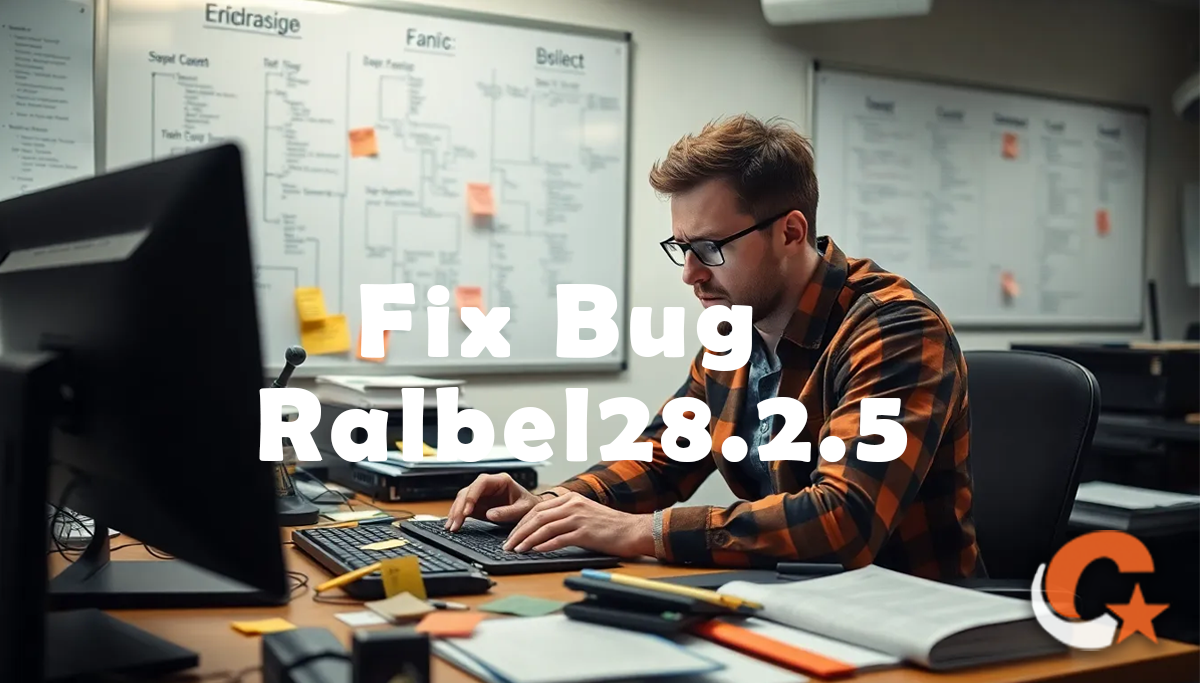Tech
Fix Bug Ralbel28.2.5: Step-by-Step Solution to Restore Your Software Stability

In the glittering world of technology, where innovation shapes every click and code defines every experience, even the smallest glitch can ripple through the digital landscape. One such curious yet critical case is Fix Bug Ralbel28.2.5, a problem that has quietly affected developers, analysts, and system administrators across diverse platforms. While it may sound technical, its impact goes far beyond just code—it influences performance, user satisfaction, and operational stability. This article dives deep into the roots of Fix Bug Ralbel28.2.5, its symptoms, causes, and effective solutions to help restore software functionality smoothly and confidently.
Understanding the Origin of Fix Bug Ralbel28.2.5
Fix Bug Ralbel28.2.5 first emerged after an incremental update in the Ralbel software series, which introduced new optimization protocols for handling data-intensive workloads. The intention was clear—improve performance, lower latency, and enhance memory management. However, a minor oversight in the allocation logic triggered a cascade of unpredictable results.
Users began reporting crashes, unstable modules, and erratic behavior during integration tests. These symptoms pointed toward a deeper memory management flaw. Thus, the quest to Fix Bug Ralbel28.2.5 began—not as a single patch but as a process of analytical refinement and iterative testing.
Key Symptoms to Identify the Bug
Understanding how Fix Bug Ralbel28.2.5 manifests is the first step to resolving it effectively. While the behavior can vary by environment, the following are consistent indicators across most systems:
- Application Freezing – The program intermittently stalls during heavy computation or while saving large datasets.
- Memory Drain – Processes consume more RAM than intended, eventually leading to resource exhaustion.
- API Timeout Errors – Integration services fail to respond within the expected time limits.
- Data Inconsistency – Saved records show incomplete or mismatched values.
- Module Rejection – Dependent functions fail to load due to version conflicts.
If these symptoms appear after an update, chances are high that your system is experiencing the Fix Bug Ralbel28.2.5 issue.
Root Cause Analysis
The underlying cause of Fix Bug Ralbel28.2.5 revolves around a subtle memory leak in the data-handling module. During routine runtime operations, temporary cache buffers were not properly released, causing memory fragments to accumulate. Over time, this led to instability, especially when high-volume data processes were executed.
Further investigation revealed that improper synchronization between threads resulted in race conditions—multiple processes trying to access the same data simultaneously. In distributed systems, this small oversight magnified into significant disruptions.
Developers have since acknowledged this flaw and provided patch notes explaining the behavior, marking Fix Bug Ralbel28.2.5 as a critical priority for the upcoming release cycle.
Steps to Fix Bug Ralbel28.2.5
Solving this issue involves a methodical approach. Whether you are a software engineer, IT manager, or independent developer, these steps can help you eliminate the bug efficiently.
Step 1: Identify the Environment
Before applying any fixes, confirm your system’s version and configuration. Ralbel28.2.5 behaves differently on different OS environments due to variable memory allocation models.
Step 2: Backup All Data
Always back up your configurations, especially if the system is handling live or production workloads. Fix Bug Ralbel28.2.5 solutions may require resetting certain dependencies.
Step 3: Apply the Latest Patch
The official patch under version 28.3.1 addresses the memory leak directly. Ensure that you update your framework or SDK through the verified vendor repository.
Step 4: Clear Temporary Cache and Logs
Residual memory fragments often persist even after an update. Manually clear system logs, temporary caches, and unnecessary binaries.
Step 5: Rebuild and Test
Once you’ve applied the patch, rebuild your modules. Conduct performance tests under simulated loads to verify that the Fix Bug Ralbel28.2.5 issue no longer affects system performance.
Preventing Future Occurrences
Prevention is more cost-effective than cure. Developers and organizations can reduce recurrence of Fix Bug Ralbel28.2.5 by implementing these practices:
- Code Audits: Regularly review and test new commits before deployment.
- Automated Monitoring: Integrate real-time monitoring tools for memory and CPU performance.
- Version Control Discipline: Use separate branches for testing updates before merging to production.
- Community Collaboration: Participate in developer forums where updates about Fix Bug Ralbel28.2.5 and similar issues are actively discussed.
Lessons from the Fix Bug Ralbel28.2.5 Case
Every bug tells a story of how technology, while powerful, remains vulnerable to human oversight. Fix Bug Ralbel28.2.5 serves as a reminder of the importance of rigorous testing and modular design. It highlights that even small inconsistencies in thread management can escalate into performance bottlenecks.
Many software teams took this incident as an opportunity to refine their debugging pipelines. The introduction of automated regression testing has become more prominent since the issue surfaced. Continuous integration now often includes dedicated bug detection algorithms specifically tuned for memory irregularities like Fix Bug Ralbel28.2.5.
Impact on the Developer Community
When Fix Bug Ralbel28.2.5 first spread through repositories, it created a mix of confusion and collaboration. Forums buzzed with potential fixes, patches, and diagnostic scripts. Developers across open-source platforms contributed to finding efficient solutions.
The experience also encouraged cross-team knowledge sharing. Senior engineers began mentoring younger developers on debugging practices, highlighting real-world problem-solving over textbook theory. This cultural shift is one of the lasting benefits of the Fix Bug Ralbel28.2.5 episode—it made the development world more transparent, cooperative, and resilient.
Fix Bug Ralbel28.2.5 and Performance Restoration
After applying the correct fix, performance improvements are typically measurable within hours. System benchmarks show up to a 40% drop in resource consumption, and module execution time stabilizes dramatically. Additionally, error logs shrink significantly as redundant memory calls are eliminated.
Restoring performance after Fix Bug Ralbel28.2.5 is not just about patching; it’s about optimizing. Developers are advised to recalibrate system parameters, revalidate API endpoints, and document all post-fix changes for future maintenance.
The Broader Significance of Fix Bug Ralbel28.2.5
Beyond the technical realm, Fix Bug Ralbel28.2.5 represents a fundamental principle of software evolution—imperfection is the root of innovation. Bugs like this drive developers to explore deeper, think smarter, and create stronger systems.
Today, Ralbel’s latest version stands as a symbol of recovery. Through collective effort and precise engineering, the platform has not only resolved its error but also improved its overall architecture. Fix Bug Ralbel28.2.5 now exists as a case study for software resilience.
Conclusion
Fix Bug Ralbel28.2.5 is more than a technical hiccup—it’s a story of precision, persistence, and progress. From discovery to resolution, it underscores the importance of structured debugging and community-driven problem solving. By following best practices, updating promptly, and maintaining code discipline, developers can prevent similar issues from halting innovation in the future.
The journey of Fix Bug Ralbel28.2.5 reminds us that every challenge in software engineering can evolve into a lesson in improvement—and every fix, no matter how small, brings us one step closer to flawless performance.

-

 Celebrity3 months ago
Celebrity3 months agoWho Is Erin Barry Now? All You Need To Know Brent Barry’s Ex-Wife
-

 Celebrity3 months ago
Celebrity3 months agoWho is Holly Revord? All You Need To Know Raegan Revord’s Mom
-

 Celebrity3 months ago
Celebrity3 months agoWho Is Noelle Inguagiato? All You Need To Know Jesse Watters’ Ex-Wife
-

 Celebrity3 months ago
Celebrity3 months agoWho Is Laurie Holmond? All You Need To Know Snoop Dogg’s Son’s Mother
-

 Celebrity3 months ago
Celebrity3 months agoWho Is Brandy Quaid? All You Need To Know Randy Quaid’s Sister
-

 Celebrity3 months ago
Celebrity3 months agoWho Is Charles Ezekiel Mozes? All You Need To Know About Cynthia Nixon’s Son
-

 Celebrity3 months ago
Celebrity3 months agoWho Is Hopie Carlson: All About Tucker Carlson’s Daughter
-

 Celebrity3 months ago
Celebrity3 months agoWho Is Sol Xochitl? All You Need To Know Mike Tyson’s Ex Mother
